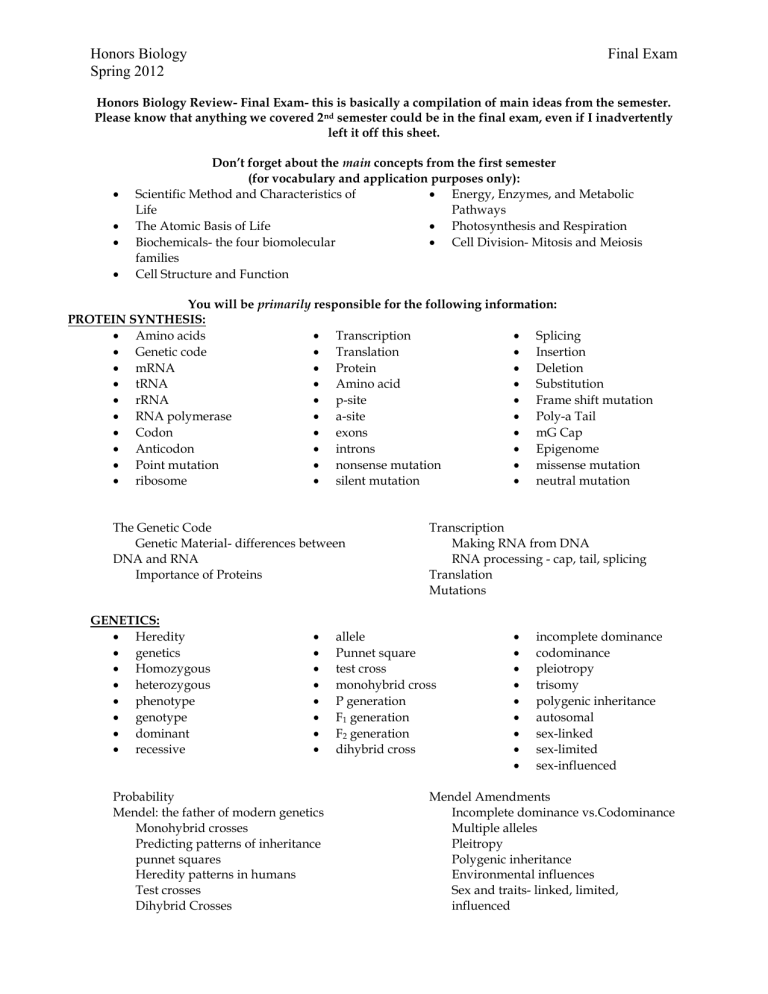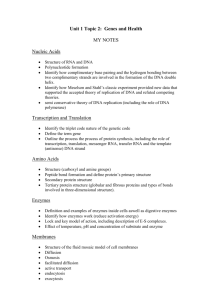Biology Review
advertisement

Honors Biology Spring 2012 Final Exam Honors Biology Review- Final Exam- this is basically a compilation of main ideas from the semester. Please know that anything we covered 2 nd semester could be in the final exam, even if I inadvertently left it off this sheet. Don’t forget about the main concepts from the first semester (for vocabulary and application purposes only): Scientific Method and Characteristics of Energy, Enzymes, and Metabolic Life Pathways The Atomic Basis of Life Photosynthesis and Respiration Biochemicals- the four biomolecular Cell Division- Mitosis and Meiosis families Cell Structure and Function You will be primarily responsible for the following information: PROTEIN SYNTHESIS: Amino acids Transcription Splicing Genetic code Translation Insertion mRNA Protein Deletion tRNA Amino acid Substitution rRNA p-site Frame shift mutation RNA polymerase a-site Poly-a Tail Codon exons mG Cap Anticodon introns Epigenome Point mutation nonsense mutation missense mutation ribosome silent mutation neutral mutation The Genetic Code Genetic Material- differences between DNA and RNA Importance of Proteins GENETICS: Heredity genetics Homozygous heterozygous phenotype genotype dominant recessive Probability Mendel: the father of modern genetics Monohybrid crosses Predicting patterns of inheritance punnet squares Heredity patterns in humans Test crosses Dihybrid Crosses Transcription Making RNA from DNA RNA processing - cap, tail, splicing Translation Mutations allele Punnet square test cross monohybrid cross P generation F1 generation F2 generation dihybrid cross incomplete dominance codominance pleiotropy trisomy polygenic inheritance autosomal sex-linked sex-limited sex-influenced Mendel Amendments Incomplete dominance vs.Codominance Multiple alleles Pleitropy Polygenic inheritance Environmental influences Sex and traits- linked, limited, influenced Honors Biology Spring 2012 APPLIED GENETICS: Blastocyst Cloning Differentiated DNA ligase Ex vivo gene delivery Gene enhancement Gene treatment In vivo gene delivery Plasmid Recombinant DNA Restriction enzyme Splicing Stem cells Transgenic organisms Undifferentiated Final Exam Artificial embryo twinning Autosomal dominant Autosomal recessive carrier DNA polymerase In vitro fertilization Karyotype Multipotent Nucleotides Pedigrees Pluripotent Primers Reproductive cloning Sticky ends Totipotent Stem cell terminology and technology Cloning- therapeutic vs reproductive and SCNT vs. Artificial Embryo Twinning Gene Therapy- Enhancements vs. treatments, delivery vectors Pedigrees Recombinant DNA molecules Assembling recombinant DNA molecules Adult stem cells DNA fingerprinting DNA probe Embryonic stem cells Gene amplification Gene therapy GMO/GE Nondisjunction Polymerase chain reaction (PCR) Restriction fragment length polymorphism (RFLP) Somatic Cell Nuclear Transfer Splicing Therapeutic cloning Vector Amplification of recombinant DNA by DNA cloning Expression of eukaryotic gene in a host cell Using Recombinant DNA GMOs Pros & Cons PCRSteps Purpose Honors Biology Spring 2012 EVOLUTION & POPULATIONS: Species Population Gene pool Allele frequency Hardy-Weinberg Genetic equilibrium Gene flow Genetic drift Bottleneck Founder effect Chemical evolution Cladograms Final Exam Homologous structures Disruption selection Sexual selection Speciation Natural selection stabilizing selection Directional selection Coevolution Extinction Gradualism Punctuated equilibrium Analogous feature The origin and history of life: The formation of the earth Evolution of autotrophs and life beyond- endosymbiotic hypothesis The history of evolutionary thought The mechanism of Evolution The basis of Evolutionary change Genetic composition of populations Factors that cause gene frequencies to change over time Hardy-Weinberg Measuring gene frequencies Prezygotic Isolating mechanism Postzygotic isolating mechanism Allopatric speciation Parapatric speciation Sympatric speciation Hybridization Divergent evolution Adaptive radiation Convergent evolution Parallel evolution Vestigial structure Speciation/the origin of species What are species? Reproductive Isolating Mechanisms Patterns of Evolution- convergent, divergent, parallel The pace of evolution- gradualism vs. punctuated equilibrium Evidence for Evolution: Determining evolutionary relationships Homologous vs. analogous features Evidence for Evolution Fossil records The anatomy of living organisms Comparative embryology Biochemistry and molecular biology INFO FROM PRESENTATIONS See Homework page for information








